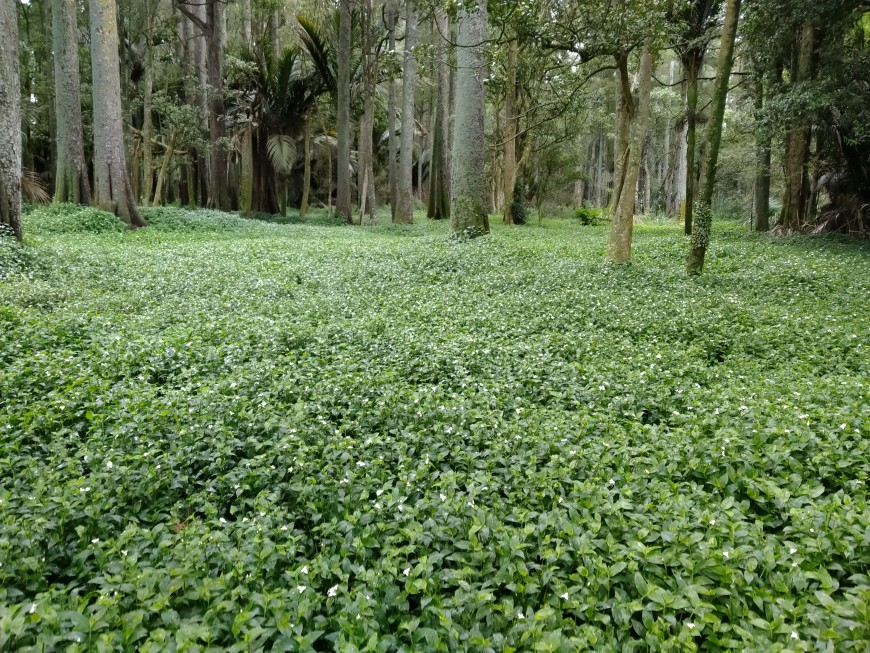The More the Merrier? Testing Efficacy of Multiple Agents

Tradescantia infestation in a Waikato forest
In response to the threat posed by tradescantia, four biocontrol agents have been released. These include the leaf beetle (Neolema ogloblini), the stem beetle (Lema basicostata), the tip beetle (Neolema abbreviata), and the yellow leaf spot fungus (Kordyana brasiliensis). All three beetle species have already proven effective in controlling tradescantia in multiple regions, most notably Northland and the Waikato. Trial releases of the fungus have also shown promising results. While the beetles have been released together in some locations, the impacts of their combined release with the yellow leaf spot fungus have yet to be assessed. Given that the beetles are less active during winter and the fungus prefers wetter conditions typical of New Zealand winters, it is hoped that their combined impacts will provide year-round control of tradescantia.
In order to investigate this, a long-term (3–5 years) field experiment was initiated in September 2020 in the Auckland, Northland and Waikato regions. The project is led by Chris McGrannachan and Zane McGrath and seeks to answer four main questions:
- How effective are the beetles and the smut fungus, both separately and in combination?
- How does biocontrol compare with herbicides in controlling tradescantia?
- What impact does tradescantia biocontrol have on native vegetation biomass, richness and regeneration?
- How does a reduction of tradescantia biomass affect other exotic plant species?
Similar trials undertaken previously in Northland showed promising early results from the beetles but could not be continued for long enough, hence this new study.
The study is being conducted at 21 native forest remnant sites on both private and conservation land. At each site, five 1.25 m2 subplots, each subjected to one of four different treatments and a control, are arranged randomly at 10 m intervals along a transect line. The four treatments include: herbicide only, beetles only, smut fungus only, and the beetles and smut fungus combined. The control and experimental subplots will be treated with an insecticide and a fungicide, as necessary, to keep the plants clean of insect and/or fungal damage, according to their assigned treatments.
“The first phase of the project is complete,” said Chris. “Zane and I have visited all 21 field sites to lay the transect lines, to demarcate the subplots, and to release the yellow leaf spot fungus. The beetles are already well established at many of the sites in Northland, so the next step is to field capture beetles for release at the remaining sites,” he added. The study sites will be revisited every 4–6 months to check on progress and to collect data. Several measurements, including environmental factors (e.g. soil moisture and canopy cover) and vegetation characteristics (e.g. tradescantia height and cover and plant species richness) will be taken at each sampling interval to assess efficacy of biocontrol versus herbicides, and efficacy of the insect and fungal biocontrol agents either alone or in combination.
“It is hoped that this study will increase our knowledge of best practice techniques in order to provide tools and guidelines to improve the long-term sustainability of New Zealand’s native forest remnants, and for improved management and control of tradescantia in these environments,” concluded Chris.
The findings from the field trial will be supplemented by the results of controlled glasshouse experiments being undertaken by University of Canterbury PhD student, Simone Cunha. Simone is conducting manipulative tests with different densities and combinations of all four tradescantia biocontrol agents to assess synergistic or antagonistic interactions between them.
This project was funded by the Ministry of Business, Innovation and Employment as part of Manaaki Whenua – Landcare Research’s Beating Weeds programme.
Contact

